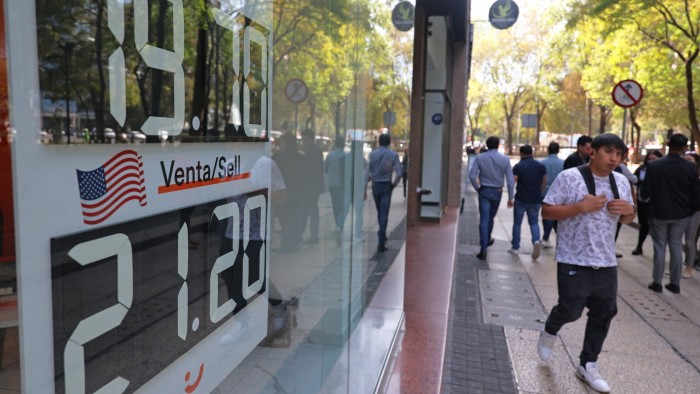
Unlock the White House Watch newsletter for free
Your guide to what the 2024 US election means for Washington and the world
Donald Trump’s tariffs shook markets early on Monday, with the Canadian dollar, Mexican peso and US stock futures sliding as investors rush to assess how the levies will affect America’s biggest trading partners.
The Canadian dollar came under pressure as trading kicked off in the Asia-Pacific region, dropping 1.4 per cent to C$1.473 against its US counterpart — the lowest level since 2003. Mexico’s peso slid more than 2 per cent to 21.15 against the dollar. The euro also lost 1 per cent.
US stock futures also fell sharply, with contracts tracking the benchmark S&P 500 losing 1.8 per cent and those tracking the Nasdaq 100 sliding 2.6 per cent.
Trading volumes are typically very thin early in the session, which can exacerbate price movements.
The steep declines came after Trump on Saturday imposed 25 per cent tariffs on all imports from Mexico and Canada, with a lower 10 per cent levy for Canadian energy, and new 10 per cent tariffs on imports from China. He also last week threatened new levies against the EU.
Economists have warned that the new tariffs are likely to accelerate inflation in the US, something that pushed up Treasury yields and the dollar following Trump’s election in November.
“The clearest implication is a stronger dollar,” said Eric Winograd, chief economist at AllianceBernstein. “A long dollar position is the cleanest, clearest expression of the trade war that is now being launched.”
“The currencies that will suffer the most are the ones against whom the tariffs are being imposed,” added Winograd, noting that “there’s a good case to be made that the equity market will suffer a little bit”.
Oil prices also climbed on Sunday evening, with international benchmark Brent crude climbing 1.5 per cent to almost $77 a barrel.
George Saravelos at Deutsche Bank said the tariff announcements were “at the most hawkish end of the protectionist spectrum we could have envisaged”, and that markets needed to “structurally and significantly reprice the trade war risk premium”.
The Mexican peso has whipsawed in recent weeks as traders have scrutinised the new Trump administration’s announcements for clues about how quickly and how extensive any new levies would be.
“If the tariff stays on for several months the exchange rate will reach new historic highs,” said Gabriela Siller, chief economist at Mexico’s Banco Base, referring to the number of pesos per dollar. “If the tariff stays on it will be a structural change for Mexico . . . and Mexico could go into a profound recession that would take years to come out of.”
By comparison, BBVA Mexico analysts said they thought it was unlikely the tariffs would last long. However, if they did remain in place, he said they would have a “very negative” impact on investment in Mexico and its competitiveness.
https://www.ft.com/__origami/service/image/v2/images/raw/https%3A%2F%2Fd1e00ek4ebabms.cloudfront.net%2Fproduction%2F12d7c3e8-cc77-4912-aa02-6a95305b82fa.jpg?source=next-article&fit=scale-down&quality=highest&width=700&dpr=1
2025-02-02 17:12:15